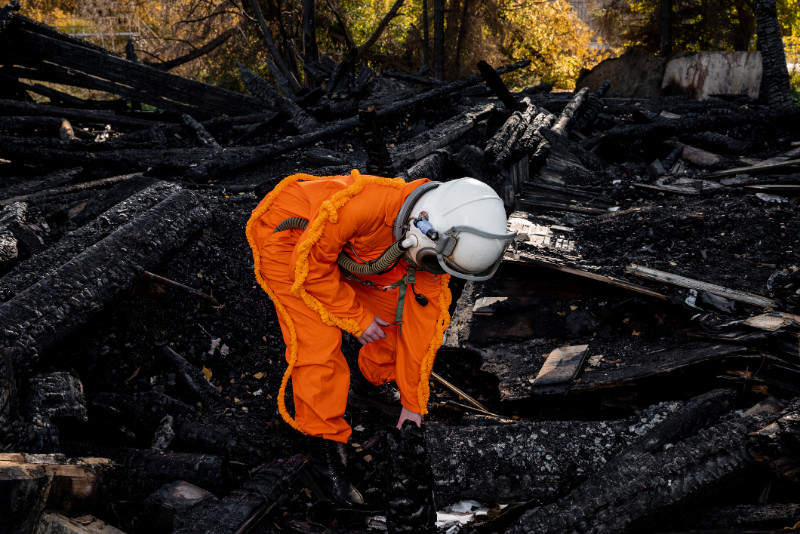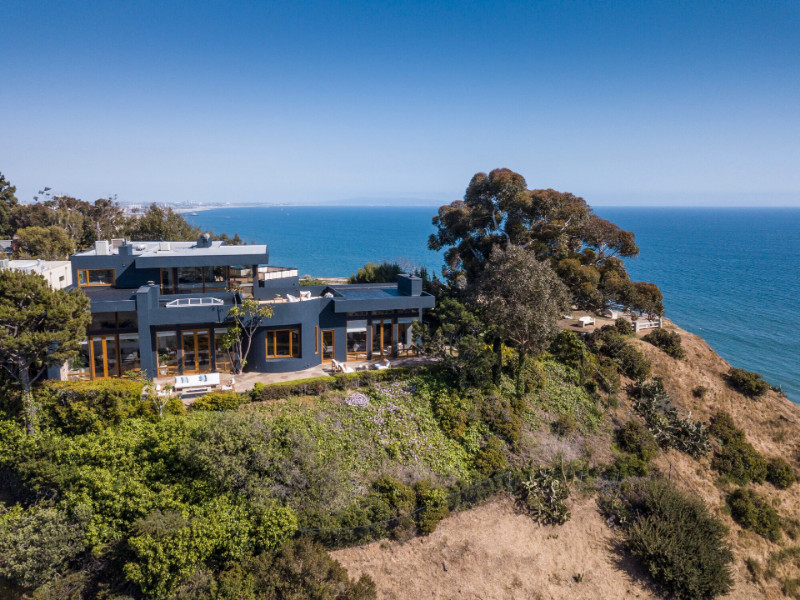Table of Contents:
- Facing the Road Together
- First Steps After the Fire: What Every Homeowner Needs to Do
- Debris Removal and Property Cleanup: What You Need to Know
- Rebuilding Stronger: How to Make Your Home More Resilient
- Moving Forward: Deciding What’s Next for Your Home
- A Future Full of Possibilities in Pacific Palisades
FACING THE ROAD TOGETHER
The recent wildfire in Pacific Palisades has left homeowners grappling with immense emotional and physical challenges. The destruction, uncertainty, and overwhelming number of decisions to make may feel paralyzing. But amid the devastation, there is a path forward.
This guide serves to help homeowners navigate the aftermath with clarity and support. From assessing damage and handling debris removal to rebuilding stronger and finding emotional support, this post provides practical steps for recovery.
Pacific Palisades luxury homes have long been sought after for their beauty and resilience. As recovery begins, each cleared lot and rebuilt home moves the community closer to a stronger, fire-resilient future.
FIRST STEPS AFTER THE FIRE: WHAT EVERY HOMEOWNER NEEDS TO DO

Staying grounded amid a crisis will help you restart on the right foot.
The period immediately following a wildfire is often overwhelming. With everything happening at the same time, it becomes difficult to know where to start.
In these moments of weakness, it helps to step back, breathe, and bring your thoughts to a mindful calm. With a clear mind, it becomes easier to determine the steps you need to take toward rebuilding.
Below is a recommended road map to your personal recovery.
-
Check if it’s safe to return to your property.
Safety is the number one priority after a wildfire. Returning too soon could expose homeowners to serious hazards, including unstable structures, toxic ash, and hidden embers that could reignite.
- WAIT FOR OFFICIAL CLEARANCE. Local authorities, fire departments, or emergency response teams will provide updates on when it is safe to re-enter affected areas. Do not attempt to return before receiving official approval.
- WEAR PROTECTIVE GEAR. When you do return, wear long sleeves, pants, gloves, an N95 mask, and sturdy shoes to protect yourself from ash and debris.
- CHECK FOR HAZARDS. Be aware of the following potential dangers:
- Hot spots or smoldering debris
- Damaged gas lines or electrical wires
- Weakened structures that may collapse
- Contaminated water supplies
- Toxic chemicals from burned materials
If you are unsure what to do after a wildfire, local fire departments and emergency response teams will provide guidance on navigating your property safely.
-
Assess fire damage and secure necessary inspections.
Once it’s safe to return, a proper assessment of the damage is essential. Sometimes, a home appears intact but smoke and water damage, compromised foundations, and weakened walls could make it unsafe.
- CONTACT A PROFESSIONAL INSPECTOR. Hire a structural engineer or licensed contractor to assess the integrity of your home. They will check for roof damage, foundation cracks, and any other structural weaknesses.
- INSPECT UTILITIES BEFORE USE. Do not turn on the gas, water, or electricity until they have been checked by a qualified professional. Fire damage may compromise wiring and gas lines, increasing the risk of explosions or electrocution.
- CHECK YOUR INSURANCE POLICY. Review your homeowners’ insurance policy to understand what is covered. Most policies will cover fire damage, but it’s important to verify details on temporary housing, debris removal, and rebuilding costs.
- SECURE YOUR PROPERTY. If your home is partially damaged but still standing, you may need to board up windows, install temporary fencing, or place tarps on exposed areas to prevent further damage from weather and trespassing.
-
Document losses for personal records and future planning.
Proper documentation of damage is critical for insurance claims, financial aid applications, and long-term planning.
- TAKE DETAILED PHOTOS AND VIDEOS. Walk through your property and capture every area – inside and out. Take close-up shots of damaged furniture, appliances, and structural elements.
- MAKE A LIST OF LOST OR DAMAGED ITEMS. Write down everything that has been affected, including furniture, electronics, clothing, and valuables. If possible, include purchase dates, costs, and receipts.
- SAVE ALL RECEIPTS AND EXPENSES. If you need to buy temporary housing and replacement items or have emergency repairs done, make sure to keep all receipts. Most costs from these purchases may be reimbursed by insurance.
- BACK UP YOUR DOCUMENTATION. Store copies of photos, videos, and lists in the cloud or on an external hard drive to ensure they are not lost.
Understanding what to do after a wildfire is key to navigating this difficult time. Proper documentation immensely helps streamline insurance claims and fast-track financial recovery, making it easier to move forward.
-
Begin the insurance claims process.
Filing an insurance claim as soon as possible helps to speed up your recovery. Many homeowners find the claims process complicated, but taking the right steps early on makes it smoother.
- CONTACT YOUR INSURANCE COMPANY. Notify your insurer about the damage and ask for specific instructions on filing a claim. Request a copy of your policy if you don’t have it on hand.
- WORK WITH AN ADJUSTER. Your insurance company will send an adjuster to inspect the damage and determine how much they will cover. Be present during this inspection and provide all documentation you’ve collected.
- REQUEST AN ADVANCE PAYMENT IF NEEDED. If you need immediate financial assistance for temporary housing or emergency repairs, ask your insurance company for an advance payment.
- CONSIDER HIRING A PUBLIC ADJUSTER. If you feel your insurance company isn’t offering a fair payout, you may hire a licensed public adjuster to advocate on your behalf.
-
Seek financial assistance and community resources.
If you’re underinsured or need additional help, several financial assistance programs are available for wildfire survivors.
- FEMA DISASTER ASSISTANCE. If the wildfire has been declared a federal disaster, FEMA may provide grants for temporary housing, repairs, and other essential needs.
- SMALL BUSINESS ADMINISTRATION (SBA) LOANS. Homeowners (not just businesses) may opt to apply for low-interest disaster loans through the SBA to help rebuild or replace lost property.
- LOCAL AID PROGRAMS. Many community organizations, nonprofits, and local government agencies offer financial assistance, emergency supplies, and other recovery resources.
-
Arrange temporary housing if needed
If your home is uninhabitable, you will need a temporary place to stay while making long-term plans.
- EXPLORE INSURANCE-COVERED OPTIONS. Many homeowners’ policies include loss of use coverage, which helps pay for temporary housing costs, such as hotel stays or rental properties.
- CHECK COMMUNITY SHELTERS AND HOUSING PROGRAMS. Local relief organizations often set up emergency shelters and provide financial assistance for those displaced by wildfires.
- CONSIDER SHORT-TERM RENTALS. If you need a place for a few months, renting a furnished home may be a better alternative to staying in a hotel.
-
Notify important contacts about your situation
Updating key individuals and organizations about your situation prevents disruptions in essential services.
- INFORM YOUR MORTGAGE LENDER. If you are struggling to make payments due to fire-related expenses, your lender may offer temporary mortgage relief options.
- CONTACT UTILITY COMPANIES. Let your gas, electricity, and water providers know if your home is damaged or uninhabitable to prevent unnecessary charges.
- FORWARD YOUR MAIL. If you’re staying in a temporary location, update your mailing address with the post office to ensure you receive important documents.
- NOTIFY YOUR EMPLOYER. If the fire has disrupted your work schedule, communicate with your employer about any necessary adjustments.
Moving forward after the first steps
Taking these initial steps will help homeowners regain control of their recovery process. The road ahead may be challenging, but understanding what to do after a wildfire makes it easier to navigate. By ensuring safety, documenting losses, seeking financial aid, and exploring temporary housing, homeowners can lay the groundwork for rebuilding or moving forward with confidence.
As Pacific Palisades rebuilds, the luxury homes lost to the fires will once again stand as testaments to resilience, strength, and the unwavering spirit of the community.
DEBRIS REMOVAL AND PROPERTY CLEANUP: WHAT YOU NEED TO KNOW

Clearing the path to recovery – debris removal is a crucial step in rebuilding Pacific Palisades after the wildfire. Trained professionals assess and safely clear charred remains, making way for a fresh start.
Clearing a property after a wildfire requires careful handling of hazardous materials, professional assistance, and awareness of potential scams.
- FOLLOW SAFETY GUIDELINES FOR HAZARDOUS DEBRIS REMOVAL. Ash, melted materials, and structural remains may contain toxic chemicals. Always wear protective gear and avoid disturbing debris without professional guidance.
- TAKE ADVANTAGE OF GOVERNMENT AND PRIVATE CLEANUP PROGRAMS. Many state and federal agencies offer assistance in debris removal, often at no cost to homeowners. FEMA, local government programs, and private contractors will help streamline the process.
- BEWARE OF SCAMS AND UNLICENSED CONTRACTORS. Disaster recovery has the tendency to attract fraudulent contractors looking to take advantage of desperate homeowners. Always verify licensing and request references and avoid paying large sums upfront.
Proper cleanup is the foundation for rebuilding, ensuring that Pacific Palisades luxury homes are restored safely and in compliance with current regulations.
REBUILDING STRONGER: HOW TO MAKE YOUR HOME MORE RESILIENT

Los Angeles luxury homes will be more resilient while never compromising quality and aesthetics.
In the aftermath of the massive wildfire that swept through Pacific Palisadesß, many affected residents are now faced with the monumental task of rebuilding. Learning from the lessons of the wildfire, the ultimate goal is for them to rebuild their homes, making them stronger, safer, and more fire-resistant.
With advancements in construction materials, design strategies, and wildfire preparedness, the risk of homes in the area getting scorched in another blaze becomes lower, essentially improving their resilience. By making smart choices now, homeowners become better equipped to protect their property and ensure long-term safety.
Designing smarter homes to withstand wildfires
Beyond materials, the overall design of a home plays a major role in reducing fire risk. Architects and builders are increasingly implementing fire-smart designs to minimize potential ignition points.
- DEFENSIBLE SPACE PLANNING. Creating buffer zones around your home helps to slow down or stop a wildfire from spreading. Best practices include:
- Maintaining a 5-foot noncombustible perimeter (gravel, concrete, or stone) around the home;
- Keeping trees and shrubs at least 10 feet away from structures; and
- Removing dried leaves, pine needles, and dead vegetation regularly.
- EMBER-RESISTANT VENTING. Wind-driven embers are one of the most common ways wildfires ignite homes. Install ember-resistant vents to prevent these firestarters from entering attics and crawl spaces.
- GUTTER PROTECTION. Fire-resistant gutter covers or screens keep debris out and prevent embers from igniting dry leaves.
- CLOSED EAVES AND SOFFITS. Embers may also enter a house via open eaves in the attic. Consider enclosing eaves and soffits with noncombustible materials.
- FIRE-RESISTANT LANDSCAPING. Choose plants that retain moisture and do not easily ignite, such as:
- Ice plant
- Agave
- Lavender
- Succulents
By adopting smarter home designs, homeowners in wildfire-prone areas significantly improve their property’s resistance to fire while maintaining the beauty and value of their homes.
Learning from homes that survived wildfires
Looking at homes that withstood past wildfires offers valuable insights into best practices for resilience. Studies have shown that certain construction techniques and property management strategies make a huge difference in a home’s chances of survival in wildfires.
COMMON FEATURES OF HOMES THAT SURVIVED
- Metal or tile roofing
- Stucco or fiber cement siding
- Minimal vegetation within 5 feet of the home
- Well-maintained defensible space
- Ember-resistant vents
- Fireproof decks and fences
Based on observations from recent wildfires, homes built or retrofitted to meet modern wildland-urban interface (WUI) fire codes had a significantly higher survival rate. These homes included non-combustible materials, well-maintained landscapes, and strategic design choices to minimize exposure to embers.
For homeowners in Pacific Palisades, applying these lessons to Pacific Palisades luxury homes offers long-term peace of mind and increased property value.
Working with trusted builders and architects specializing in resilient construction
Make sure to find the right professionals who will help you rebuild or retrofit your home. Not all contractors have experience with fire-resistant construction, so it’s important to work with those who specialize in wildfire resilience.
- SEEK OUT WUI-CERTIFIED BUILDERS. The WUI Building Code outlines standards for homes built in fire-prone areas. Builders with experience in these codes will ensure your home meets the highest fire-resistant standards.
- HIRE ARCHITECTS WITH FIRE-SAFE DESIGN EXPERTISE. Architects who specialize in fire-resilient construction will incorporate features like defensible space, ember-resistant structures, and fire-resistant materials.
- TAKE ADVANTAGE OF INCENTIVES. Some insurance companies offer discounts for rebuilding with fire-resistant materials. Research incentives that may offset the costs of upgrading your home.
By working with the right professionals, homeowners may rest assured their properties are not just rebuilt but rebuilt stronger.
Browse homes for sale in Pacific Palisades, CA
MOVING FORWARD: DECIDING WHAT’S NEXT FOR YOUR HOME

Working with professionals like James Respondek will give you great insight before coming to this big decision.
Homeowners in Pacific Palisades are now faced with the following options post-wildfires: to rebuild, relocate, or sell. Each option comes with unique considerations.
- EVALUATE THE COST AND FEASIBILITY OF REBUILDING. Depending on insurance payouts, construction costs, and personal circumstances, rebuilding may or may not be the best choice. Consulting with financial advisors and builders will clarify the options.
- CONSIDER WHETHER TO RELOCATE. Some homeowners may choose to move to a different part of Pacific Palisades or beyond. The decision to relocate should factor in personal preferences, financial readiness, and future risk levels.
- EXPLORE SELLING AS AN OPTION. If rebuilding isn’t financially or emotionally feasible, selling the property – either as-is or after minor improvements – could be a practical alternative. Pacific Palisades luxury homes remain desirable, and buyers may see an opportunity to invest in the area’s future.
Despite the challenges, what to do after a wildfire is ultimately about making the best decision for your future while considering the strength and appeal of the Pacific Palisades community.
Browse homes in other areas of Los Angeles.
A FUTURE FULL OF POSSIBILITIES IN PACIFIC PALISADES

Pacific Palisades will bounce back even better than before.
Recovery takes time, but Pacific Palisades is no stranger to resilience. The community’s strength, combined with careful planning and thoughtful rebuilding, will shape an even stronger future.
Homeowners are encouraged to take recovery one step at a time, seek support when needed, and remember that they are not alone. Pacific Palisades luxury homes will once again thrive, offering safe and beautiful spaces for families to build new memories.
By focusing on both individual and community recovery, homeowners may now move forward with confidence, knowing that the best days are still ahead.
If you’re navigating the recovery process and considering your options, top California Realtor James Respondek is ready to provide personalized advice on rebuilding, selling, or finding a new home. Visit jamesrespondek.com to explore available properties and connect with a trusted professional. To set up a meeting, contact 310.488.4400 or send a message.



